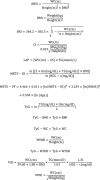Negative association between 15 obesity- and lipid-related indices and testosterone in adult males: a population based cross-sectional study
- PMID: 39863911
- PMCID: PMC11762110
- DOI: 10.1186/s12944-025-02436-6
Negative association between 15 obesity- and lipid-related indices and testosterone in adult males: a population based cross-sectional study
Abstract
Background: An association exists between obesity and reduced testosterone levels in males. The propose of this research is to reveal the correlation between 15 indices linked to obesity and lipid levels with the concentration of serum testosterone, and incidence of testosterone deficiency (TD) among adult American men.
Methods: The study utilized information gathered from the National Health and Nutrition Examination Survey (NHANES) carried out from 2011 to 2016. The condition known as TD is typically characterized by a total serum testosterone level that falls below 300 ng/dL. The analysis used weighted linear and logistic regression methods to announce the association between 15 obesity- and lipid-related factors and serum testosterone levels as well as TD. Subgroup analyses were further carried out to confirm and validate the findings. Additionally, restricted cubic spline plots were utilized to examine non-linear relationships. Receiver operating characteristic (ROC) curves were created for the 15 factors, and the area under the curves (AUC) was calculated to assess the efficacy of each factor in detecting TD.
Results: Among a group of 3,540 adult males, it was observed that all 15 obesity- and lipid-related indices showed a negative relationship with testosterone concentration and a direct correlation with the presence of TD. After accounting for all covariates, the analysis revealed that individuals within the highest quartile (Q4) for metabolic score for visceral fat (METS-VF) had the excellent probability of developing TD (OR = 13.412, 95%CIs: 4.222, 42.262, P < 0.001). Additionally, a non-linear relationship was detected between the METS-VF with TD. Within the model that incorporated all adjustments, the triglyceride glucose-waist to height ratio (TyG-WHtR) has the best performance for predicting TD (Overall: AUC = 0.762, 95%CIs: 0.743, 0.782, cut-off = 5.186).
Conclusion: Elevated levels of these 15 markers were inversely related to testosterone levels and were indicative of an elevated risk of TD. Among all indices analyzed, TyG-WHtR demonstrated the highest predictive value.
Trial registration: Not available.
Keywords: Cross-sectional study; NHANES; Obesity; Testosterone.
© 2025. The Author(s).
Conflict of interest statement
Declarations. Ethics approval and consent to participate: This study was reviewed and approved by the NCHS Ethics Review Board. All patients and participants provided written informed consent to participate in the study. Consent for publication: All participants provided informed permission for publication. Competing interests: The authors declare no competing interests.
Figures





Similar articles
-
Prediction of testosterone deficiency using different screening indexes in adult American men: An NHANES cross-sectional study.PLoS One. 2025 Jun 9;20(6):e0323900. doi: 10.1371/journal.pone.0323900. eCollection 2025. PLoS One. 2025. PMID: 40489567 Free PMC article.
-
Association of triglyceride glucose-related obesity indices with sarcopenia among U.S. adults: a cross-sectional study from the National Health and Nutrition Examination Survey.Sci Rep. 2025 Jan 2;15(1):574. doi: 10.1038/s41598-024-84278-3. Sci Rep. 2025. PMID: 39747346 Free PMC article.
-
Obesity- and lipid-related indices as a predictor of obesity metabolic syndrome in a national cohort study.Front Public Health. 2023 Feb 14;11:1073824. doi: 10.3389/fpubh.2023.1073824. eCollection 2023. Front Public Health. 2023. PMID: 36875382 Free PMC article.
-
Association between weight-adjusted waist index and testosterone deficiency in adult American men: findings from the national health and nutrition examination survey 2013-2016.BMC Public Health. 2024 Jun 24;24(1):1683. doi: 10.1186/s12889-024-19202-5. BMC Public Health. 2024. PMID: 38915014 Free PMC article.
-
Association between cardiometabolic index and testosterone levels in adult men: NHANES 2011-2016.PLoS One. 2024 Aug 28;19(8):e0306401. doi: 10.1371/journal.pone.0306401. eCollection 2024. PLoS One. 2024. PMID: 39196919 Free PMC article.
Cited by
-
Association between the oxidative balance score and testosterone deficiency in males: a cross-sectional study.Front Nutr. 2025 Jul 23;12:1577823. doi: 10.3389/fnut.2025.1577823. eCollection 2025. Front Nutr. 2025. PMID: 40771217 Free PMC article.
References
-
- Allen NE, Appleby PN, Davey GK, Key TJ. Lifestyle and nutritional determinants of bioavailable androgens and related hormones in British men. Cancer Causes & Control : CCC. 2002;13(4):353–63. - PubMed
-
- Bello-Chavolla OY, Almeda-Valdes P, Gomez-Velasco D, Viveros-Ruiz T, Cruz-Bautista I, Romo-Romo A, Sánchez-Lázaro D, Meza-Oviedo D, Vargas-Vázquez A, Campos OA, Sevilla-González MDR, Martagón AJ, Hernández LM, Mehta R, Caballeros-Barragán CR, Aguilar-Salinas CA. METS-IR, a novel score to evaluate insulin sensitivity, is predictive of visceral adiposity and incident type 2 diabetes. Eur J Endocrinol. 2018;178(5):533–44. - PubMed
-
- Bello-Chavolla OY, Antonio-Villa NE, Vargas-Vázquez A, Viveros-Ruiz TL, Almeda-Valdes P, Gomez-Velasco D, Mehta R, Elias-López D, Cruz-Bautista I, Roldán-Valadez E, Martagón AJ, Aguilar-Salinas CA. Metabolic Score for Visceral Fat (METS-VF), a novel estimator of intra-abdominal fat content and cardio-metabolic health. Clinical Nutrition (Edinburgh, Scotland). 2020;39(5):1613–21. - PubMed
-
- Berkseth, K. E., K. B. Rubinow, S. J. Melhorn, M. F. Webb, M. Rosalynn B De Leon, B. T. Marck, A. M. Matsumoto, J. K. Amory, S. T. Page and E. A. Schur (2018). "Hypothalamic Gliosis by MRI and Visceral Fat Mass Negatively Correlate with Plasma Testosterone Concentrations in Healthy Men." Obesity (Silver Spring, Md.) 26(12): 1898–1904. - PMC - PubMed
MeSH terms
Substances
LinkOut - more resources
Full Text Sources
Medical

